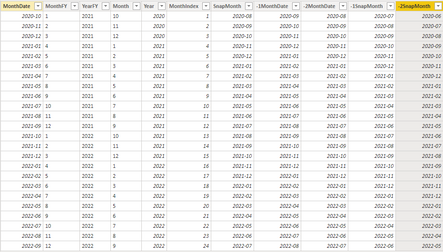Join us at FabCon Vienna from September 15-18, 2025
The ultimate Fabric, Power BI, SQL, and AI community-led learning event. Save €200 with code FABCOMM.
Get registered- Power BI forums
- Get Help with Power BI
- Desktop
- Service
- Report Server
- Power Query
- Mobile Apps
- Developer
- DAX Commands and Tips
- Custom Visuals Development Discussion
- Health and Life Sciences
- Power BI Spanish forums
- Translated Spanish Desktop
- Training and Consulting
- Instructor Led Training
- Dashboard in a Day for Women, by Women
- Galleries
- Data Stories Gallery
- Themes Gallery
- Contests Gallery
- Quick Measures Gallery
- Notebook Gallery
- Translytical Task Flow Gallery
- TMDL Gallery
- R Script Showcase
- Webinars and Video Gallery
- Ideas
- Custom Visuals Ideas (read-only)
- Issues
- Issues
- Events
- Upcoming Events
Enhance your career with this limited time 50% discount on Fabric and Power BI exams. Ends September 15. Request your voucher.
- Power BI forums
- Forums
- Get Help with Power BI
- Desktop
- Sum with 2 filters based on 1 selected date in the...
- Subscribe to RSS Feed
- Mark Topic as New
- Mark Topic as Read
- Float this Topic for Current User
- Bookmark
- Subscribe
- Printer Friendly Page
- Mark as New
- Bookmark
- Subscribe
- Mute
- Subscribe to RSS Feed
- Permalink
- Report Inappropriate Content
Sum with 2 filters based on 1 selected date in the slicer
Hi Experts
I have a table of forecast with 2 columns for months, DemandMonth and SnapMonth (see below, all in date format), and the DemandMonth is linked to MonthDate in the time master (see below). The objective is to sum Value in forecast based on the selected Monthdate plus the related SnapMonth.
The 1st phase is simple, just sum the value of the month selected. I did a measure below which works.
Look forward to your comments. Thanks
Time Table
Solved! Go to Solution.
- Mark as New
- Bookmark
- Subscribe
- Mute
- Subscribe to RSS Feed
- Permalink
- Report Inappropriate Content
@Anonymous , if they connected the sleected value is no a good idea , If the time table is disconnected
Try like
Measure1 = CALCULATE(SUM('Forecast'[Value]),FILTER('Forecast',[DemandMonth] in values('Time'[MonthDate])&&'Forecast'[SnapMonth]=SELECTEDVALUE('Time'[SnapMonth])))
Measure2 = CALCULATE(SUM('Forecast'[Value]),FILTER('Forecast',[DemandMonth] In values('Time'[-1MonthDate]) && 'Forecast'[SnapMonth] in values('Time'[-1SnapMonth])))
Also explore userelationship, if you want to need one table at a time
https://www.youtube.com/watch?v=e6Y-l_JtCq4
- Mark as New
- Bookmark
- Subscribe
- Mute
- Subscribe to RSS Feed
- Permalink
- Report Inappropriate Content
@Anonymous , if they connected the sleected value is no a good idea , If the time table is disconnected
Try like
Measure1 = CALCULATE(SUM('Forecast'[Value]),FILTER('Forecast',[DemandMonth] in values('Time'[MonthDate])&&'Forecast'[SnapMonth]=SELECTEDVALUE('Time'[SnapMonth])))
Measure2 = CALCULATE(SUM('Forecast'[Value]),FILTER('Forecast',[DemandMonth] In values('Time'[-1MonthDate]) && 'Forecast'[SnapMonth] in values('Time'[-1SnapMonth])))
Also explore userelationship, if you want to need one table at a time
- Mark as New
- Bookmark
- Subscribe
- Mute
- Subscribe to RSS Feed
- Permalink
- Report Inappropriate Content
Thanks@amitchandak, I tried to disconnect the time table with the forecast, and found it works!!!!




